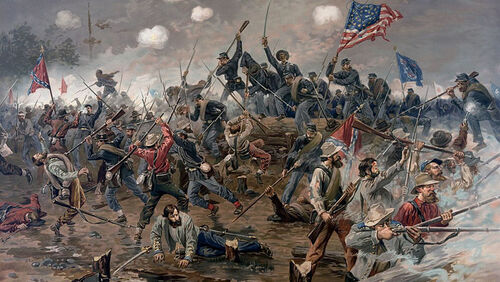-
Why human society isn’t more—or less—violent than in the past.
Why human society isn’t more—or less—violent than in the past.
As populations scale up, the proportion of people killed in battle scales down, suggesting we’re no more or less violent than our forebears who lived in smaller societies.
Are people in big, modern societies more or less violent than our forebears? The answer is neither, according to a controversial new study: People who lived in small bands in the past had no more proclivity toward violence than we do today. The finding—based on estimates of war casualties throughout history—undercuts the popular argument that humans have become a more peaceful species over time, thanks to advances in technology and governance. But some critics aren’t convinced.
That includes the man who most recently popularized the idea, psychologist Steven Pinker of Harvard University, who calls the new findings “a statistical gimmick.” He argues in his 2011 book The Better Angels of Our Nature: Why Violence Has Declined that the emergence of institutions like nation-states with strong central governments, trade networks, and wide-ranging communication increased interdependence and reduced deaths due to violence. He cited data suggesting that fewer people die in wars today, relative to a society’s total population, than among small tribes of hunter-gatherers, pastoralists, and horticulturalists—how human society organized for most of its history.
But a team led by anthropologist Rahul Oka at the University of Notre Dame in Indiana wondered whether there was a mathematical explanation for why fewer people proportionally are lost to violence nowadays. They reasoned that as populations get bigger, their armies don’t necessarily grow at the same rate. In a small group of 100 adults, for example, it would be perfectly reasonable to have 25 warriors, says anthropologist and study co-author Mark Golitko, also at Notre Dame. But in a population of 100 million, supporting and coordinating an army of 25 million soldiers is logistically impossible, to say nothing of such an army’s effectiveness. Researchers call that incongruity a scaling effect.
The scientists dug through dusty tomes and digital archives to put together a list of 295 societies and 430 battles, large and small, dating from 2500 B.C.E. to today. They plotted two data sets: one comparing overall population size and the size of that society’s fighting force, and another comparing army size and casualty rate.
For example, a 1771 battle among warring factions of New Zealand’s Maori people involved 60 warriors—about 1% of their total population. When 10 people died in that conflict, the Maori lost about one-tenth of a percent of its population. By comparison, during the U.S. Civil War’s Battle of Gettysburg in Pennsylvania in 1865, roughly 150,000 soldiers fought (less than 0.5% of the divided nation’s population). About 5745 died in that battle, resulting in the loss of only a miniscule fraction of the overall population.
Plotting these battles and hundreds like them, Oka and his team found that the larger the population, the fewer people proportionally fought and died in battle, the researchers report this week in the Proceedings of the National Academy of Sciences. Taken together, the results suggest that as population scales up, per capita casualties of violence scale down, regardless of governance, shared commerce, or technology.
Because researchers like Pinker ascribe the nonviolence trend to institutions like governance and trade rather than simple scaling, Golitko says, they overestimate violent tendencies in smaller societies. The paper comes out a month after another article similarly denounced Pinker’s claims that modern society is less violent than in the past.
Pinker, though, is unconvinced. Fitting numbers to an equation in this way gives only a narrow look at one type of violence—battle casualties—and fails to examine violence more broadly, including the massacres of civilians that sometimes follow battles or raids. “In a larger society … not all the men are warriors, and not all people are vulnerable to raids and battles, so you’re safer from violence,” he says in a statement to Science. “[The study’s findings] are not an alternative to this kind of explanation; they are not an explanation at all.”
But such criticisms miss the point, Oka says. The researchers never attempted to look at motivations for violence, he says. Instead, they set out to show that by using population scaling, researchers might be able to put historical and modern violence in context. “Some might take that to mean our species has always been violent,” he says. “But the flip side is, we are also as peaceful as we’ve always been.” (By Michael Price. Dec. 2017).
http://www.sciencemag.org/news/2017/12/why-human-society-isn-t-more-or-less-violent-past
-
Commentaires

